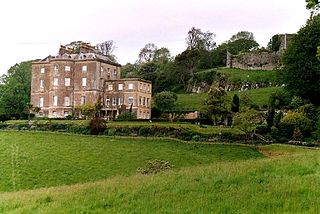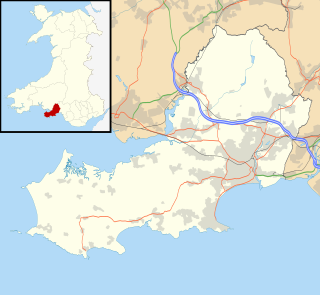
Swansea is a coastal city and county in Wales. The county is officially known as the City and County of Swansea. Swansea, which includes Swansea Bay and the Gower Peninsula, is on the southwest coast of Wales and within the historic county boundaries of Glamorgan and the ancient Welsh commote of Gŵyr. Swansea is the second largest city in Wales and the twenty-fifth largest city in the United Kingdom. Swansea is the second most populous local authority area in Wales with a population of 241,300 in 2014. Together with Neath and Port Talbot, Swansea formed a wider Urban Area of 300,352 in 2011.

Glamorgan, or sometimes Glamorganshire, is one of the thirteen historic counties of Wales and a former administrative county of Wales. Originally an early medieval petty kingdom of varying boundaries known as Glywysing, then taken over by the Normans as a lordship, the area that became known as Glamorgan was both a rural, pastoral area, and a conflict point between the Norman lords and the Welsh princes. It was defined by a large concentration of castles.

Gower or the Gower Peninsula in southwest Wales, projects towards the Bristol Channel. It is the most westerly part of the historic county of Glamorgan. In 1956, the majority of Gower became the first area in the United Kingdom to be designated an Area of Outstanding Natural Beauty.

The Bristol Channel is a major inlet in the island of Great Britain, separating South Wales from Devon and Somerset in South West England. It extends from the lower estuary of the River Severn to the North Atlantic Ocean. It takes its name from the English city of Bristol, and is over 30 miles (50 km) wide at its western limit.

Cefn Sidan, translated from Welsh, means "silky ridge". This long sandy beach and its dunes form the outer edge of the Pembrey Burrows between Burry Port and Kidwelly, facing southwestwards over Carmarthen Bay in South Wales. Cefn Sidan beach is backed by dunes, salt marshes, Pembrey Forest and the Pembrey Country Park.

Three Cliffs Bay, otherwise Three Cliff Bay, is a bay on the south coast of the Gower Peninsula in the City and County of Swansea, Wales. The bay takes its name from the three sea cliffs that jut out into the bay. Pennard Pill, a large stream, flows into the sea in the middle of the bay.

Penrice Castle is a 13th-century castle near Penrice, Swansea on the Gower Peninsula, Wales. Nearby is a neo-classical mansion house built in the 1770s.

Oxwich Bay is a bay on the south of the Gower Peninsula, Wales.

Oystermouth Castle is a Norman stone castle in Wales, overlooking Swansea Bay on the east side of the Gower Peninsula near the village of the Mumbles.

Oxwich Castle is a Grade I listed castle which occupies a position on a wooded headland overlooking Oxwich Bay on the Gower Peninsula, Wales. Although it may occupy the site of an earlier fortification, it is a castle in name only as it is a grand Tudor fortified manor house built in courtyard style.

Llangennith is a village in the City and County of Swansea, South Wales. It is located in the Gower. Moor Lane leads westwards to a caravan park near Rhossili Bay and Burrows Lane leads northwards to a caravan park overlooking Broughton Bay. The village has a scattering of houses, centred on St Cenydd's church, and the King's Head pub.

Port Eynon is a village and community within the City and County of Swansea, Wales, located on the far south tip of the Gower Peninsula within the designated Area of Outstanding Natural Beauty. The A4118 from Swansea city centre terminates here.

Loughor Castle is a ruined, medieval fortification located in the town of Loughor, Wales. The castle was built around 1106 by the Anglo-Norman lord Henry de Beaumont, during the Norman invasion of Wales. The site overlooked the River Loughor and controlled a strategic road and ford running across the Gower Peninsula. The castle was designed as an oval ringwork, probably topped by wicker fence defences, and reused the remains of the former Roman fort of Leucarum.

Pennard is a village and community on the south of the Gower Peninsula, about 7 miles south-west of Swansea city centre. It falls within the Pennard electoral ward of Swansea. The Pennard community includes the larger settlements of Southgate and Kittle. the population as of 2011 was 2,688.

Pennard Castle is a ruined castle, near the modern village of Pennard on the Gower Peninsula, in south Wales. The castle was built in the early 12th century as a timber ringwork following the Norman invasion of Wales. The walls were rebuilt in stone by the Braose family at the turn of the 13th and 14th centuries, including a stone gatehouse. Soon afterwards, however, encroaching sand dunes caused the site to be abandoned and it fell into ruin. Restoration work was carried out during the course of the 20th century and the remains of the castle are now protected under UK law as a Grade II* listed building.

The Gower and Swansea Bay Coast Path is part of the Wales Coast Path, an 1,400-kilometre (870 mi) long-distance walking route around the whole coast of Wales that opened in 2012. The Gower and Swansea Bay stretch is 156 kilometres (97 mi) in length, running along the coast of the Gower Peninsula from Loughor, Swansea to Kenfig Dunes near Port Talbot, South Wales. The number of people using the Wales Coast Path in the Swansea local authority area was 349,333.

The Church of St Illtyd is Grade II* Listed Building in the city and county of Swansea in south Wales. It is 1 km from Oxwich village, on a site overlooking Oxwich Bay and reached by the Wales Coast Path. It has a square churchyard with a stone wall and a modern gate. The church was originally listed on 6 March 1964. The church was originally dedicated to Hylledd, and no reason is known as to why it was changed.
Penrice is a village and community in Swansea county, Wales on the Gower peninsula. It had a population of 451 as of the 2011 UK census and includes the villages of Oxwich and Horton. Penrice has an elected community council.
The geology of the Gower Peninsula in South Wales is central to its character and to its appeal to visitors. The peninsula is formed almost entirely from a faulted and folded sequence of Carboniferous rocks though both the earlier Old Red Sandstone and later New Red Sandstone are also present. Gower lay on the southern margin of the last ice sheet and has been a focus of interest for researchers and students in that respect too. Cave development and the use of some for early human occupation is a further significant aspect of the peninsula's scientific and cultural interest.

















